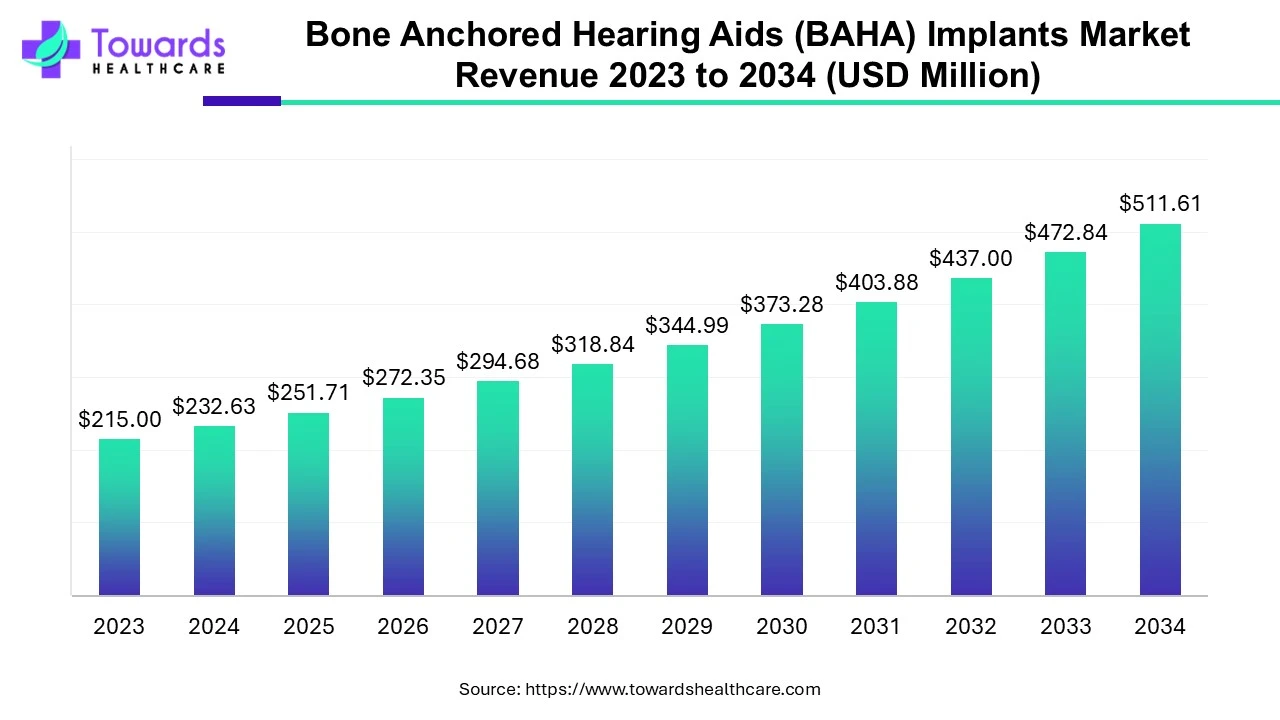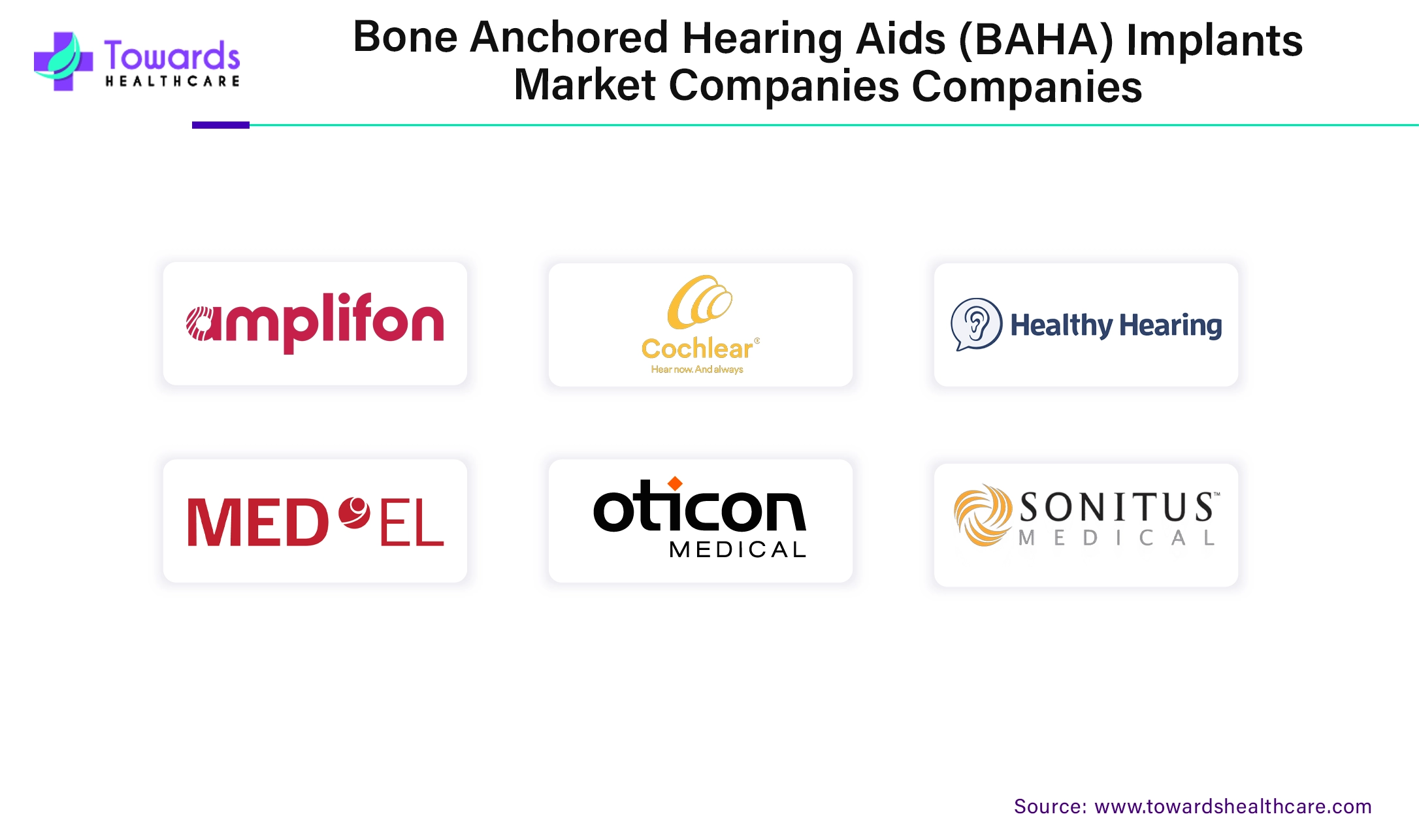April 2025

The bone anchored hearing aids (BAHA) implants market size was estimated at US$ 215 million in 2023 and is projected to grow to US$ 511.61 million by 2034, rising at a compound annual growth rate (CAGR) of 8.2% from 2024 to 2034. The rising incidences of hearing aid problems and the latest innovations in the medical device sector drive the market.

Bone-anchored hearing aids (BAHA) are surgically implantable devices for people having outer or middle ear problems but at least one functioning inner ear (cochlea). BAHA sends sound waves through the bones of the skull directly into the cochlea. It consists of three parts: titanium implant, external connector, and sound processor. They are most widely used in patients with chronic otitis media, mastoiditis, and single-sided deafness. BAHA is usually suggested for children with underdeveloped ear canal or outside parts of the ear. It offers several advantages, such as better comfort, optimal sound quality, and better prediction of results.
The rising incidences of hearing aid problems, such as conductive or mixed hearing loss and single-sided deafness, potentiate the use of BAHA. According to the WHO, approximately 2.5 billion people globally are estimated to require some degree of hearing loss by 2050. The growing research and development activities and the latest innovations in the medical device sector promote the market.
The sales revenue of Cochlear Limited for the half year ended December 2023 increased by 25% to $1,113 million, with strong growth in cochlear implants and sound processor upgrades. The statutory net profit of the company increased 35% to $191 million.
Novel innovations in the BAHA system can improve patient adherence and enhance user experience. The growing research and development activities globally are evolving with the changing needs of patients and designing more effective hearing aids at lower prices. The most general trend in hearing devices is to make them aesthetically appealing or to make them as invisible as possible. The transcutaneous hearing aids have lesser visibility than the percutaneous ones. Improvements in the screw and abutment design and the introduction of less invasive surgical techniques can reduce or eliminate the complications associated with skin penetration. Hence, the demand for minimally invasive surgical techniques promotes innovations.
The major disadvantage of the market is the high cost of the device. The average cost of a BAHA ranges from $10,000 to $17,000. The device also needs an external sound processor, which costs around $5,000 to $8,000. This restricts many patients from using BAHA, especially in low- and middle-income countries.
North America dominated the bone anchored hearing aids (BAHA) implants market in 2023. The rising incidences of hearing impairment, technological advancements, the presence of key players, and the advanced research & development facilities. Hearing loss is rising in the US and is expected to double by the year 2060. According to the National Institute on Deafness and Other Communication Disorders, approximately 615,000 individuals have Meniere’s disease, and around 45,000 new cases are diagnosed annually in the US. It is estimated that around 7% of the US adult population has unilateral hearing loss. According to a 2022 report by the Hearing Review, approximately 60,000 to 65,000 new cases of sudden sensorineural hearing loss (SSHL) are documented in the US annually. Cochlear Limited was the first company to market BAHA in the US.
Asia-Pacific is expected to grow at the fastest rate in the bone anchored hearing aids (BAHA) implants market during the forecast period. The rising incidences of hearing loss, growing research and development, increasing investments & collaborations, and favorable government policies drive the market. There are approximately 27 million people affected by hearing loss in China. The Chinese local governments are incorporating cochlear implants into their public health insurance schemes to reduce the cost of healthcare for residents. In August 2024, the southern island province of Hainan became the latest region to extend coverage to cochlear implant surgery. Under the ADIP scheme by the Indian Government, free cochlear implants, post-operative therapy, and rehabilitation for children with hearing impairment. In 2022-23, 1,151 cochlear implant surgeries were performed in India under the scheme. In July 2024, the Australian Government funded 6.5 million Australian dollars ($4.4 million) for the Japanese hearing implant program for children.
By type, the children type segment led the global bone anchored hearing aids (BAHA) implants market in 2023. The incidences of conductive and mixed hearing loss and single-sided deafness are higher in children compared to the adult population. It is estimated that more than 34 million children globally suffer from deafness or hearing loss. Children under 5 years or less are more likely to require BAHA implants.
The adult type segment is predicted to witness notable growth in the market over the forecast period. The rising incidences of hearing loss cases in adults, especially in the geriatric population, potentiate the segment growth.
By application, the perceptual hearing loss segment accounted for a considerable share of the bone anchored hearing aids (BAHA) implants market in 2023. Perceptual hearing loss or sensorineural hearing loss is a condition in which the inner ear is damaged. BAHA implants are predominantly used in sensorineural hearing loss. BAHA implants directly send sound waves to the inner ear, where the bones in the skull vibrate to aid hearing.
The behavioral hearing maintenance segment will gain a significant share of the market over the studied period. The behavioral hearing test involves observing how a child responds to sounds of varying intensities. BAHA implants help children to adapt to changing sound intensities.

By Type
By Application
By Region
April 2025
October 2024
December 2024
April 2025